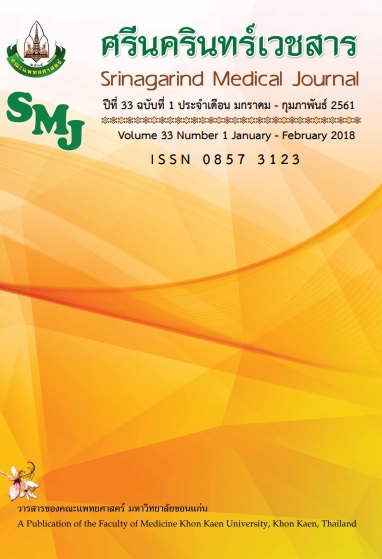Efficiency of Orientin Inhibits HMGB1: Potential Adjunct Therapeutic Agent for Septicemic Melioidosis in a Mouse Model
Keywords:
Orientin; melioidosis; HMGB1; Burkholderia pseudomallei; ออเรียนติน; โรคเมลิออยโดสิส; โปรตีน HMGB1; แบคทีเรีย BurkholderiapseudomalleiAbstract
Background and Objective: HMGB1 is a potent proinflammatorycytokine in septicemic melioidosis patients. The HMGB1 level was found to be correlated with severity of the disease. The aim of this study was to investigate the effective of the potential of HMGB1-inhibitor, orientin, as an adjunct therapeutic agent in septicemicmelioidosis mice.
Methods: Four groups of BALB/c mice were infected with Burkholderiapseudomalleito inducesepticemicmelioidosis. The infected mice were then treated with various substances including group I) Phosphate Bufferred Saline (PBS), group II) Ceftazidime (CTZ), 300 mg/kg,group III) Orientin (Ori) 36 µg/mouseand group IV) Orientin combines with Ceftazidime (Ori/CTZ) at the same concentrations with group I) and II) and observed their survival. Blood samples of infected mice were collected to determine the number of bacteria in blood and HMGB1 level in plasma.
Results: CTZ and Ori/CTZ-treated groups gave the highest survival rate at 33.3%, followed by Ori-treated group with 11.1%. The highest median survival time was found in CTZ- and Ori/CTZ-treated groups. The bacteria count in blood was found only in Ori-treated group and PBS-control group. HMGB1 showed the highest level in Ori-treated group.
Conclusion: Ori as an adjunctive to suboptimal dose of CTZ could not improve the potential of treatment in mice with septicemicmelioidosis. Moreover, administration of orientin alone trended to increase number of bacteria in blood and HMGB1 level in a mouse model of melioidosis.
ประสิทธิภาพของออเรียนตินต่อการยับยั้งโปรตีน HMGB1 เมื่อใช้ในการร่วมรักษาโรคติดเชื้อเมลิออยด์แบบติดเชื้อในกระแสเลือดในหนูทดลอง
รัชทิยา เทียบมา1, อรุณี แปยาว2, สุรศักดิ์ วงศ์รัตนชีวิน1,2*
1ภาควิชาจุลชีววิทยา คณะแพทยศาสตร์ มหาวิทยาลัยขอนแก่น
2ศูนย์วิจัยโรคเมลิออยโดสิส คณะแพทยศาสตร์ มหาวิทยาลัยขอนแก่น
หลักการและวัตถุประสงค์:โปรตีน HMGB1 เป็นตัวกระตุ้นการอักเสบที่มีบทบาทสำคัญในผู้ป่วยที่ติดเชื้อเมลิออยด์ในกระแสเลือด ระดับของ HMGB1 ถูกพบว่าสัมพันธ์กับความรุนแรงของโรค การศึกษานี้มีวัตถุประสงค์เพื่อสืบสวนประสิทธิภาพของสารออเรียนติน (orientin) ที่สามารถยับยั้ง HMGB1 ในการร่วมรักษาหนูที่ติดเชื้อเมลิออยด์ในกระแสเลือด
วิธีการศึกษา:หนู BALB/c จำนวน 4 กลุ่ม (กลุ่มละ 6 ตัว) ถูกทำให้ติดเชื้อ Burkholderiapseudomalleiเพื่อชักนำให้เกิดภาวะติดเชื้อในกระแสเลือด และให้การรักษาด้วยสารต่าง ๆ ดังนี้ กลุ่มที่ 1 Phosphate Buffered Saline (PBS) กลุ่มที่ 2 ออเรียนติน(Ori) ความเข้มข้น36 ไมโครกรัมต่อตัว กลุ่มที่ 3 เซฟตาซิดีมที่มี dose ต่ำ (CTZ) ความเข้มข้น300 มิลลิกรัมต่อกิโลกรัม และกลุ่มที่ 4 Ori ร่วมกับ CTZ (Ori/CTZ) ที่ความเข้มเข้นเดียวกันกับกลุ่ม 2 และ 3 จากนั้น สังเกตความมีชีวิตรอด และเก็บตัวอย่างเลือดเพื่อตรวจดูจำนวนแบคทีเรียในเลือดและปริมาณของ HMGB1 ในพลาสมา
ผลการศึกษา:กลุ่มที่ให้การรักษาด้วย CTZ และ Ori/CTZ มีอัตราการมีชีวิตรอดสูงสุด ร้อยละ 33.3 รองลงมาคือกลุ่ม Ori ร้อยละ 11.1 ค่ากลางเวลามีชีวิตรอดสูงสุด คือ กลุ่มที่ให้การรักษาด้วย CTZ และ Ori/CTZแบคทีเรียในเลือดถูกตรวจพบเพียงในกลุ่มที่ให้การรักษาด้วย Ori และกลุ่มควบคุม PBS ส่วนระดับ HMGB1 พบสูงสุดในกลุ่ม Ori
สรุป:การรักษาด้วย Oriร่วมกับ CTZ ไม่สามารถเพิ่มประสิทธิภาพในการรักษาหนูที่ติดเชื้อเมลิออยด์ในกระแสเลือด มากไปกว่านั้น การให้Ori อย่างเดียวทำให้จำนวนแบคทีเรียในเลือดและระดับ HMGB1 ในพลาสมาเพิ่มขึ้น




